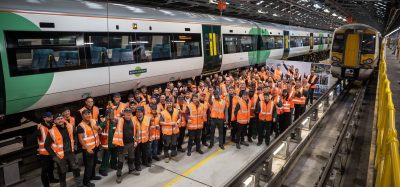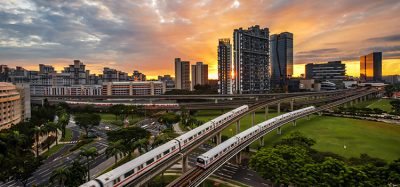Strong port investments to create efficient Intermodal links
Posted: 26 September 2007 | | No comments yet
Infrabel, the infrastructure manager of the Belgian railway network, is investing strongly in the extension of a competitive, suitable railway infrastructure in various Belgian ports. These extensions support the development of the ports and will improve intermodality between rail and water. In an interview with Global Railway Review, Luc Lallemand, CEO of Infrabel, speaks about the challenges, strategy and Infrabel’s port investments.
Infrabel, the infrastructure manager of the Belgian railway network, is investing strongly in the extension of a competitive, suitable railway infrastructure in various Belgian ports. These extensions support the development of the ports and will improve intermodality between rail and water. In an interview with Global Railway Review, Luc Lallemand, CEO of Infrabel, speaks about the challenges, strategy and Infrabel’s port investments.
Infrabel, the infrastructure manager of the Belgian railway network, is investing strongly in the extension of a competitive, suitable railway infrastructure in various Belgian ports. These extensions support the development of the ports and will improve intermodality between rail and water. In an interview with Global Railway Review, Luc Lallemand, CEO of Infrabel, speaks about the challenges, strategy and Infrabel’s port investments.
According to various studies, freight traffic at various Belgian ports is on the increase. This increase concerns not only the ports of Antwerp and Zeebrugge but also the smaller ports of Ghent, Brussels, Ostend, Liège and Athus. For this reason, Infrabel is involved in various infrastructure projects in order to extend railway capacity and to support the expansion of the ports. By means of well-considered investment planning, the aim is to increase the share of the railways in the ports by making full use of existing and future railway potential. To follow is an overview of the most important infrastructure projects and investments in the various ports.
The port of Antwerp
The new Deurganckdok, which came on stream in the summer of 2005 on the left bank of the river Scheldt and is meant for containers, has considerably increased the amount of container traffic. In recent years, Infrabel has laid various new tracks and bundles to provide access to this new port infrastructure and is actively working on future related projects (such as laying several new track bundles and branch tracks). Total investment in railway structure on the Antwerp left bank, including the Deurganckdok, is €100 million, yielding extra capacity and 153km of additional track.
The new railway infrastructure around the Deurganckdok is only the first step in an attempt to deal with the increase in freight traffic. A direct rail link between the left bank (Waaslandhaven) and the right bank (Antwerpen-Noord marshalling yard) is therefore essential. This will be the Liefkenshoek rail link. This new rail link under the river Scheldt is very important for improved access from the port to the hinterland. The building of the link will ease the burden of heavy traffic in the Kennedy tunnel, currently the only railway tunnel under the river. Rail traffic from the Deurganckdok will become quicker and more efficient as it will no longer have to be diverted via the nearly saturated hub of Berchem, but instead will be able to go directly to Antwerp-North where the trains are assembled.
The financing of the project will be done by means of a PPP (Public Private Partnership) for the construction work (estimated total cost of €770 million after indexation). The laying of the railway infrastructure will be financed by Infrabel to the tune of €60 million. The project will be completed as quickly as possible due to this method of financing. The Flemish Region will bear the costs of pre-financing up to a particular amount (?107 million). The tendering of this PPP project will cover both construction and financing. The procedure, which began in April 2006, should be completed by the beginning of 2008. The start of construction is planned for the spring of 2008 and the start of operations of the Liefkenshoek rail link for 2012.
Infrabel is also examining the laying of a second rail access to the port of Antwerp. This project includes the building of a new 28km long dual-track line for the transport of freight between the Antwerpen-Noord station and the Lier-Aarschot railway line. The second rail access will increase the capacity of the right bank and is crucial for the further development of Antwerp port. This project is currently being worked out and will be a major priority in Infrabel’s 2008-2012 investment plan.
As the result of the recognition of the historical rights of Belgium to the Iron Rhine by the Court of Arbitration in The Hague, Infrabel is actively participating in the reopening of this axis. The railway line allows for quicker transport of heavier freight between the port of Antwerp and the German Ruhr Area via Neerpelt and The Netherlands. The Iron route (162km) is shorter and faster than the complementary Montzen axis (211km) – the other railway link to Germany – and contributes to an increase in flexibility and capacity. The reopening of the Iron Rhine is currently being negotiated between the countries concerned – Belgium, The Netherlands and Germany. Total investment in the reopening of the Iron Rhine (expected to be in 2015) is estimated at approximately €700 million (the costs on Belgian and Dutch territory).
Apart from large-scale projects, Infrabel will continue in the coming years with a series of small-scale investment projects which will greatly increase rail capacity in the port of Antwerp. For example, the Ghent arch (investment worth €5 million) will link the Antwerp left bank directly with the port of Zeebrugge and the north of France. Construction started in the summer of 2006 and should be finished by the end of 2007. By 2012 on the right bank, two large branches in Schijn (just outside Antwerp-North) and on the Krijgsbaan (Mortsel) will increase the capacity of the Antwerp-Germany axis by 30%. This investment will total around €160 million and will be the first phase of the second rail access to the port of Antwerp.
Port of Zeebrugge
The most important project in the strategically situated port of Zeebrugge is the modernisation and increase in capacity of the Zeebrugge-Vorming formation yard. Apart from the laying of an extra bundle with 24 tracks, the existing, separated track bundles will be turned into one large hub with 30 track shunting routes. With a view to concentrating its signal boxes, Infrabel will also be building a new signal box in Zeebrugge-Vorming. The execution of all these projects will be done in phases and should be completed by 2015. Infrabel is investing €130 million (estimated total cost after indexation) in Zeebrugge-Vorming. The Flemish Region will be contributing €13 million to cover the costs of pre-financing.
To the south of the Zeebrugge-Vorming station, the Ter Doest arch will provide a direct link between the western and eastern port areas. This new rail link (an investment worth €8 million) will, as from 2010, not only ensure time saving but also more capacity and flexibility on the line between Zeebrugge and Brugge.
Infrabel is also actively engaged in extending various rail bundles in the port of Zeebrugge: Voorhaven-West, Pelikaan, Ramskapelle and Wielingen. These infrastructure projects include the laying of extra tracks, their electrification and signal mechanisms. Construction work is planned for the 2007-2009 period and represents an investment of €22 million.
Due to the laying of a third track between Zeebrugge and Bruges, the rail section between Bruges station and the Blauwe Toren fork, which is currently being intensively used for the transport of passengers and freight, will be able to deal with the increase in traffic and will also ensure improvement of the connections to the hinterland. Infrabel will be starting the laying of the third track in 2011 which should be ready by 2016. The investment amounts to €65 million.
Lastly, Infrabel is working on the extension of the railway line between Ghent and Bruges. The 50A Ghent-Bruges line is a major link in the Belgian railway network for transport of both passengers and freight. Given the expected increase in transport to and from the port of Zeebrugge, the number of tracks on this line will be doubled from two to four. This work will be done in several phases. The first phase of construction work began in 1994. The project will be completed by 2018. Fast trains will then be able to travel on the two tracks in the middle and the local trains and freight trains will use the two outside tracks. With the completion of the third and fourth tracks, capacity can be extended to allow for faster train traffic. This fits in with Infrabel’s strategy, as does the dismantling of all level crossings between Ghent and Bruges. Safety is an absolute priority for Infrabel. The company will be investing a total of €350 million in this important mobility project.
Other Belgian ports
Infrabel also has plans for other ports. In Ghent, it is investing €36 million in the modernisation of a semi-automatic marshalling yard and the laying of an arrival and departure bundle by 2010. In Ostend, it intends to finish the laying of a new rail line between Oostende-Vorming and the Plassendale bundle (?4 million). The two receiver bundles and the rail connection to the terminal will be renewed in Athus (?1 million). Infrabel has renewed the tracks in Renory and has ensured improved service to the port of Liège by laying a third track (funded by the Walloon Ministry of Equipment and Transport). Lastly, Infrabel wants to extend and renew the rail installations in the port of Brussels by 2009 in collaboration with the Brussels Capital Region (Infrabel’s investment is €6 million).
Conclusion
An important role for Infrabel in intermodal freight transport
With all these investments in various Belgian ports, Infrabel has demonstrated that it is a very important partner in the field of freight transport. The aim is to maximise the potential of its railway infrastructure and to systematically increase its share in container traffic in the various ports. For example, in the port of Antwerp Infrabel intends to increase the share of rail traffic from the present 8% to some 15% by 2020.
In addition, Infrabel would like to make the rail infrastructure available as quickly as possible to rail operators in various stages. Infrabel is thus anticipating the increase in freight traffic transport and enabling the ports of Antwerp and Zeebrugge to develop as one of the most important economic areas of growth at both world and European level.
Luc Lallemand, CEO of Infrabel, concludes the ports and the railways are natural partners. It is therefore extremely important to extend this complementary and close relationship with Infrabel playing a major role as pioneer in intermodal freight transport.
About the author
Mr. Luc Lallemand is currently CEO of Infrabel and Chairman of the Management Committee. Mr. Lallemand has a Bachelor seamanship and certificate of officer of long trade navigation. Mr. Lallemand is also a Commercial Engineer. He has worked in various organisations including Financial Advisor with the Department of Treasury at SNCB, Deputy Principal Private Secretary with the Cabinet of the Vice Prime Minister and Chief Financial Officer of SNCB between 2002 and 2004. Mr. Lallemand holds the position as Director with De Post, Vinçotte, Eurostation and Chairman of the Board of Directors with TUC RAIL.
Stay Connected with Global Railway Review — Subscribe for Free!
Get exclusive access to the latest rail industry insights from Global Railway Review — all tailored to your interests.
✅ Expert-Led Webinars – Gain insights from global industry leaders
✅ Weekly News & Reports – Rail project updates, thought leadership, and exclusive interviews
✅ Partner Innovations – Discover cutting-edge rail technologies
✅ Print/Digital Magazine – Enjoy two in-depth issues per year, packed with expert content
Choose the updates that matter most to you. Sign up now to stay informed, inspired, and connected — all for free!
Thank you for being part of our community. Let’s keep shaping the future of rail together!







